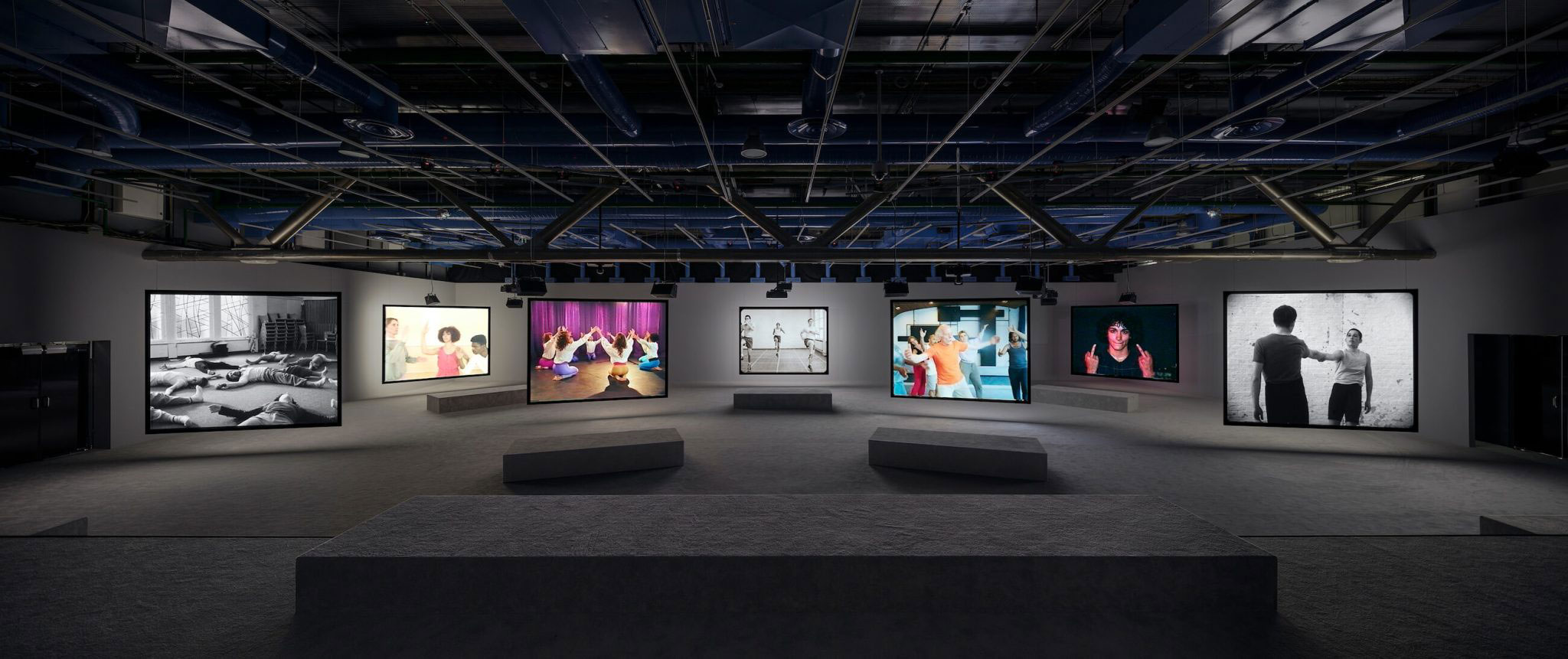PRESENTATION: Jeremy Shaw-Phase Shifting Index
 Jeremy Shaw works in a variety of media to explore altered states and the cultural and scientific practices that aspire to map transcendental experience. Often combining and amplifying strategies of verité filmmaking, conceptual art, music video and scientific research, he creates a post-documentary space in which disparate belief-systems and histories are thrown into an interpretive limbo.
Jeremy Shaw works in a variety of media to explore altered states and the cultural and scientific practices that aspire to map transcendental experience. Often combining and amplifying strategies of verité filmmaking, conceptual art, music video and scientific research, he creates a post-documentary space in which disparate belief-systems and histories are thrown into an interpretive limbo.
By Efi Michalarou
Photo: MAC Montreal Archive
A vast, immersive, seven-channel video installation—the culmination of Jeremy Shaw’s work of the last few years “Phase Shifting Index” is an exhilarating, para-scientific reverie of enormous intellectual and artistic ambition. “Phase Shifting Index” depicts seven autonomous groups engaged in embodied, movement-based belief systems that aspire to induce parallel realities. Employing various outmoded 20th-century media, ranging from 16mm film to Hi-8 video tape, Shaw presents what appears to be documentary footage as the distant future, creating cognitive dissonance within the viewers’ relation to a sense of place and time. The dress, style and choreography of the subjects suggest found historical footage from the 1960s to the 1990s. Through variations of modern dance, popping and locking, jump-style, hardcore skanking, and trust exercises, they explore the potentials of physically altering reality. At the peak of the dramatic action, the films begin to come undone in an ecstatic chaos that lands the entire seven-channel installation in a cross-temporal choreographic sync. This cohesive moment of dance spans across decades of time and media. Suddenly, all screens rupture in a meltdown of digital visual effects that consume the installation. Shaw subverts viewers’ trust in the truthfulness conferred by documentary strategies, transporting the audience to uncharted artistic and sensorial territory, while exploring how altered states and embodied corporeal practices also transform the perception of time. The work seems to explore the gap between the timeless notion of transcendence and the scientific attempts to explain, locate and define it. Beautifully combining staged documentary, choreography, evocations of spiritual practices, neuroscientific research, drug-induced psychedelic revelations, club subcultures, visual effects, music and alternative movement therapies, the screens conspire in an intriguing narrative that unfolds skillfully and inexorably into thrilling chaos. The artwork culminates in an inevitable, yet surprising, “transtemporal” synchronized collective ecstasy—with all the subjects on all the screens performing the same hypnotic dance. A breathtaking glimpse of rapture. Drawing from his research into altered states, counter-culture, and transcendence, Jeremy Shaw creates video installations that complicate our expectations of the moving image as a form of testimony. Shaw refers to his work as parafictional, or post-documentary. By blurring the line between primary document and the social imaginary, Shaw builds speculative worlds that mirror our culture’s psychological fracturing. In early works such as “DMT” (2004), “10,000 Hits of Black Acid” (2005), and “Anti-Psych” (2006), Shaw explored the mind-altering potential of drug use. For “Best Minds Part One” (2008), Shaw began with video depicting the crowd at a straight-edge hardcore concert, a subset of the hardcore punk scene that practices abstinence from drugs and alcohol. Shaw slowed down the footage until the moshers appeared to move in time with a soundtrack of the artist’s own ambient music. With a few simple transpositions, Shaw reframed the violent movements and transformed the scene into a vibrant group catharsis. His widely lauded “Quantification Trilogy” (2014-18) is set in the future after the discovery of the mechanics of spiritual ascension. In the three parafictional short films, marginalized groups discuss their beliefs and embodied movement practices. Employing outdated visuals, clothing, and hairstyles to depict the future, Shaw probes the fundamental human desire for transcendence and its countless subjective interpretations. While in residence at Callie’s in 2019 and 2020, Shaw prepared choreography, rehearsed, and filmed his monumental video installation, “Phase Shifting Index”, which premiered in the artist’s solo exhibition at the Centre Pompidou, Paris, in 2020.
Photo: Jeremy Shaw, Phase Shifting Index, 2020, Seven-channel video installation, colour, sound, 24 min 20 sec, Installation view at Centre Pompidou, Paris. Photo: Timo Ohler, Courtesy the artist and Bradley Ertaskiran
Info: Curators: John Zeppetelli and Raphaëlle Cormier, Musée d’art contemporain de Montréal (MAC) at Fonderie Darling, 745 Ottawa Street, Montréal, Québec, Canada, Duration: 12/12/2023-25/2/2024, Days & Hours: Tue-Fri 11:30-19:00, Sat 11:00-18:00, Sun 11:00-17:30, https://macm.org/

